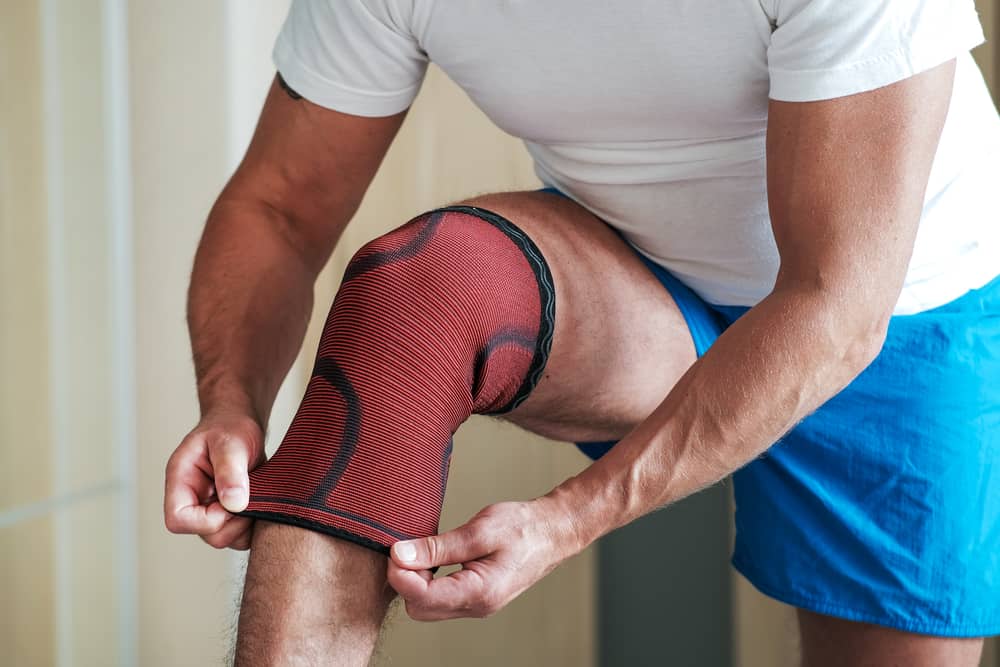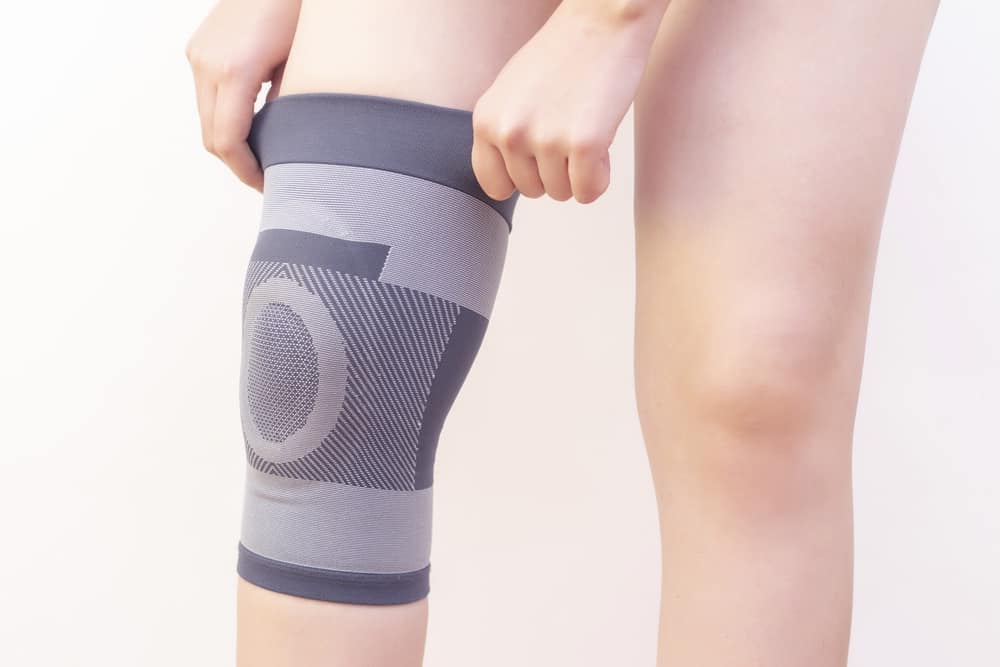How Long Can You Wear a Knee Compression Sleeve
Compression can do wonders for your joints and muscles, whether you’re using it for recovery after an injury or just for prophylaxis.
The hardest thing about using a knee brace is figuring out how often you actually need to wear it, though.
How long can you wear a knee compression sleeve, and do you need to take it off during the night?
Generally, it’s recommended to only wear it for a few hours every day to avoid the negative side effects. Let’s find out all about that!

How Knee Compression Sleeves Work
The key to making the most out of knee braces is to balance the benefits with the side effects, but this requires a base understanding of how they work.
Before we dig into all that, let’s first take a look at five different ways that compression sleeves can help you:
1. Supports Your Knees
The main concept behind the typical knee brace is that it provides support. That’s because knee pain can be significantly reduced when the pressure is elevated from the tendons.
Padded ones can also absorb the shocks during intense physical activity to reduce injuries like patellar dislocation by stabilizing the joint in place.
2. Reduces Knee Pain
Some compression sleeves are more structured with rigid frames that limit your joint movement in several planes.
This means that they keep you from moving your knees beyond their natural range to reduce straining and pain while you exercise.
A tight-fitting but soft knee sleeve can be even better for reducing chronic pain in patients with osteoarthritis.
The only issue here is that they can be a bit restrictive at times, which is largely why it isn’t a good idea to overuse a brace, but we’ll get to that in a minute!
3. Boosts Oxygenation
Knee braces might also work by increasing the blood flow from the leg muscles and back into the heart to reduce swelling.
This is a good feature to speed up recovery after intense workouts by combating soreness and inflammation.
In a way, it can also make sure your muscles are getting enough oxygenation to keep the fatigue and cramping away.
4. Keeps You Warm
On a different note, the increase in circulation can also keep the knee compression sleeve surprisingly warm. That’s not only a comfortable feeling, but it can also boost muscle performance.
Sometimes, knee sleeves have an additional feature that allows you to use a heating pad and an electric massager.
5. The Good-Old Placebo Effect
Oddly, the placebo effect can have a lot to do with how well knee compression sleeves affect your body.
Just the subconscious notion that wearing this brace is good for your joints might be enough for some people, especially if the sleeve is particularly comfortable or supporting.
Either way, a knee compression sleeve effect is often a blend of all the different effects working in harmony.

How Long Can You Wear a Knee Compression Sleeve Safely?
While you can absolutely wear a knee compression sleeve all day, there’s no added benefit there. In fact, you could end up doing more harm than good.
With minor injuries that heal without surgical intervention, wearing the compression sleeve for a week might be enough.
If your knee pain doesn’t improve after this week, it’s better to go for a quick check-up.
It’s also worth noting that you don’t have to wear the sleeve on both knees if the pain is unilateral.
However, you’ll need to be a bit mindful with your stride so that you don’t depend too much on one leg.
A lot of people find that it’s much easier to put on compression sleeves in the early morning because the legs might be slimmer then.
Not only does this put you at risk of overusing the sleeve, but as the day goes on, it might seem enticing to just keep wearing the brace through the night.
Should you wear your brace while sleeping?
For most people, there’s no reason to wear the knee compression sleeve to bed. That’s because you probably don’t even bend and move your joints all that much when you’re sleeping anyway.
Remember that the main risk is from bending your knee beyond its normal range of safe movement.
Instead, it’s recommended to wear the sleeves during the most active hours of the day and take them off later. You can also use it when your acute joint pain flares up.
If you want a bit of extra comfort for the night, try using pillows or ice packs.
Keep in mind that the right way to prop your knees up is by putting the pillow under your ankle and calf. This way, your joints remain extended and reduce joint swelling a bit.
Wearing a Knee Brace Post-Surgery
Structured knee braces are a bit different than the soft compression sleeves, though. The braces are usually way less comfortable and stiff, but they provide rigid support.
These braces are typically used for post-surgical care. That’s because they prevent you from bending your knees beyond a certain limit.
For instance, your physician could prescribe you a supportive brace for around six weeks after an ACL reconstruction surgery. You might also need to use crutches during your recovery timeline.
For a meniscus surgery, you need to put on the brace anywhere between two to six weeks.
Keep in mind this kind of procedure can take a toll on your body, and the entire recovery period could take six months on end.
All in all, you’ll need to get in touch with your physician to ask about the exact period that you might need to wear knee braces or sleeves after a surgical procedure.

What’s the Risk of Wearing a Knee Brace for Too Long?
The side effects of wearing a knee brace for too long can range from minor inconveniences to serious problems.
For one, it could just be uncomfortable to restrict your legs all day. Other times, the sleeve might leave marks and irritate your skin, especially if you don’t use one made of breathable fabrics.
On a more serious note, your legs are even more susceptible to swelling around the joints if you’re wearing a sleeve that’s way too tight for a long period.
In some cases, when people wear a sleeve on only one knee, they tend to overcompensate by favoring the other leg. In the long run, this might cause joint stiffness.
How to Avoid the Downsides of Knee Compression Sleeve
Whether you’re recovering from surgery or just suffering from chronic pain, sometimes, there’s no way around wearing your knee sleeve for prolonged periods.
In cases like this, it’s good to know how to limit the not-so-pleasant effects, from skin irritation to joint stiffness.
Let’s take a look at five tips that can help you out:
1. Know When to Take It Off
The key to preventing damage from wearing a compression sleeve for too long is simply staying within the resealable limits.
Even the most serious surgical rehab programs have a scheduled time where you can take it off for showers or physical therapy sessions.
So, start by setting certain limits. For most people, this means wearing it during the times when you’re most active during the day only.
2. Wash Your Knee Sleeves Often
Regardless of how long you wear your knee sleeves, make sure you wash them often, especially if you exercise in them.
Otherwise, you risk soaking your skin in all that sweat and bacteria, which isn’t a pleasant thought at all.
If you’re supposed to wear the knee sleeve for an extended period, it might be smart to change the brace entirely after six months or so of regular usage.
Not only for hygiene reasons but also because it could lose its elasticity very quickly.
3. Find the Right Sleeve
Choosing the right sleeve can go a long way when you’re trying to reduce the side effects of knee braces.
The right knee compression sleeve should be made out of breathable material, and it should be tight without pinching your skin.
That’s why using an adjustable one is a good option if you can’t find your size easily.
4. Get a Professional Opinion
If you adjust how often you wear your knee compression sleeve but you’re still feeling uncomfortable, you might be overdue for a physical checkup.
You could be using the wrong type or size of brace for your condition. You might also not need to put on any knee bracing at all!
5. Don’t Rely on the Sleeve Too Much
Sleeves can be helpful, but don’t let them lull you into a false sense of protection.
In the end, there’s only so much that a knee compression sleeve can do for you.
A bad running posture or an unbalanced stride can still cause an injury, with or without braces.
A compression sleeve will never replace physical therapy.
So, make sure you’re giving your body all the care it needs. Even if you’re not injured at all, you still need to do your stretches and warm-ups.
Final Thoughts On How Long Can You Wear a Knee Compression Sleeve
All in all, a knee compression sleeve can be a lifesaver for active people with joint pain. It stabilizes your knees, reduces swelling, warms you up, and gets your circulation going.
The key is using it in moderation. If overused, you could risk getting skin irritations, joint stiffness, and leg swelling.
How long can you wear a knee compression sleeve? In short, you can wear it for a few hours on end during the day when you’re most active and take it off during the night.
Rehabilitative braces, of course, are a whole other story, and they could be worn for over a month post-surgical procedures.
